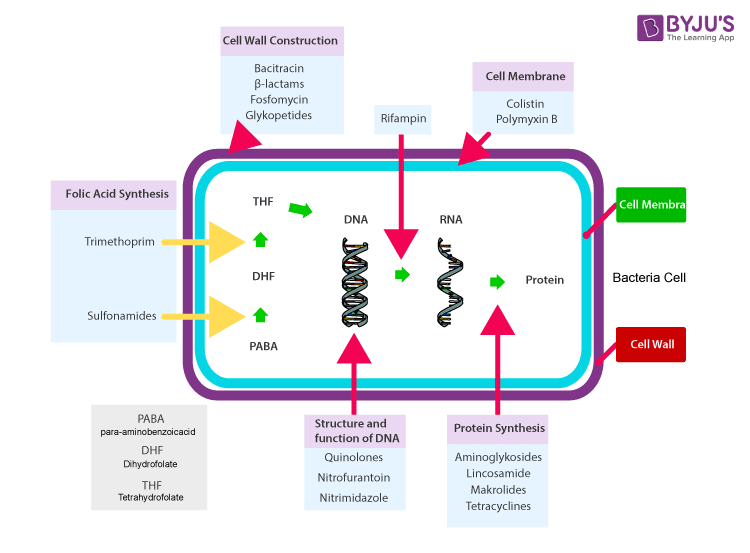What are Antibiotics?
Antibiotics are medicines that are used to treat as well as prevent bacterial infections. They inhibit growth and sometimes destroy the microorganisms that cause infections.
Antibiotics use is encouraged because it is fairly harmless to human beings and animals. It treats diseases caused by bacteria by inhibiting the synthesis of their cell walls and sometimes by interfering in the functioning of their DNA.
Table of Contents
- Antibiotics Definition
- History of Antibiotics
- Who Discovered Antibiotics
- How do Antibiotics work?
- Recommended Videos
- Types of Antibiotics
- Side Effects of Antibiotics
- Frequently Asked Questions – FAQs

Antibiotics Definition
Antibiotics can be defined as a type of antimicrobial drug which is used for the treatment and prevention of bacterial infections by inhibiting the growth of the bacteria. They are not effective when used for diseases caused by viruses, for example, cold or flu. Viruses are infectious agents which live in the cells of a host that cannot survive on their own. It needs a host to produce its protein for it. So by using this, we cannot cure viral diseases and it can even affect humans by interfering with their cells.
History of Antibiotics
Originally antibiotic was obtained naturally from microorganisms. Later, after the advancement in synthetic methods, synthetic antibiotic was also developed. In the nineteenth century, Paul Ehrlich, a German bacteriologist started looking for a chemical that can kill the bacteria in human’s or animals’ bodies but does not adversely affect the health of humans or animals. After various researches, he discovered the medicine arsphenamine, also known as salvarsan. It was used to treat the disease called syphilis which is caused by the bacteria spirochete. He got Nobel Prize for medicine in 1908 for his work on Immunity. Although salvarsan was having some side effects on humans, the impact of medicine on the bacteria was much more than that on humans.
In 1932, another drug called prontosil was discovered by a team of Researchers at Bayer Laboratories which was similar to the compound salvarsan which converts into sulphanilamide when it is taken into the body.
But the real transformation in antibacterial therapy took place with the discovery made by Alexander Fleming in 1929, of the natural antibiotic penicillin.
Who Discovered Antibiotics?
With the discovery of the natural antibiotic penicillin, Alexander Fleming is credited with the discovery of antibiotics.
How do Antibiotics work?
Even though there are plenty of different types of antibiotics, they work in basically two ways.
- Certain antibiotics get rid of the bacteria by killing it, like penicillin. They generally disrupt the formation of the cell wall or cell contents of the bacteria.
- The other kind of bacteria inhibits the multiplying action of the bacteria.
Recommended Videos

Types of Antibiotics
Antibiotics are basically classified based on their chemical structure. Antibiotics with the same structural class will showcase similar properties of effectiveness, toxicity, and allergy potential. They are:
- Penicillins
- Cephalosporin
- Macrolides
- Fluoroquinolones
- Sulfonamides
- Tetracyclines
- Aminoglycosides
Based on how they work on stopping the infection of the bacteria, they can again be classified as:
-
Bactericidal
They kill the bacteria present in the body which causes disease.
For e.g.:- Penicillin and polymyxin. -
Bacteriostatic
The medicines which are used to inhibit the growth of microbes are known as bacteriostatic.
For e.g.:- Tetracycline, Chloramphenicol.
On the basis of the range of action of antibiotics, they are divided as:
- Broad-spectrum
It can be classified as drugs that destroy or inhibit the growth of a wide range of gram-positive and gram-negative bacteria.
For e.g.:– Amoxicillin - Narrow spectrum
These types of medicines mainly attack Gram-positive bacteria or gram-negative bacteria.
For e.g.:– Penicillin G - Limited spectrum
It is effective against a specific kind of organism or disease.
Side Effects of Antibiotics
Antibiotics are generally cross-checked several times before permitting it for any clinical use. But still, there are some of them which have an adverse side effects on its use. Side effects depend on the type of antibiotic used, and the microbes which are targeted and it also varies from person to person. Generally, side effects are not that serious with some general side effects being nausea, soft stools (faeces) and diarrhoea.
Some side effects of antibiotics are:
- Anorexia
- Increased Appetite
- EKG changes
- Epistaxis (Nosebleed)
- Gout
- Hepatotoxicity
- Hiccups
- Hyperkalemia
- Joint Pain (Arthralgia)
- Kidney Stones (Nephrolithiasis)
- Libido, Decreased
- Libido, Increased
- Myalgia (Muscle Pain)
- Nasal Congestion
Frequently Asked Questions – FAQs
What are antibiotics’ simple definitions?
Antibiotics are medicines that are used to treat bacterial illnesses in humans and animals. They work by either killing germs or making it difficult for them to grow and multiply.
Why are antibiotics used?
Antibiotics are drugs that are used to treat or prevent bacterial infections. They don’t work against viral infections like the common cold or the flu. Antibiotics should only be used to treat minor health issues that are unlikely to resolve without the use of antibiotics, such as acne.
What happens to your body when you take antibiotics?
Antibiotics can have a variety of negative side effects. Antibiotics are known to cause nausea, diarrhoea, and allergic responses. Antibiotics can also kill naturally existing bacteria that protect the body from yeast infections, thus yeast infections can happen to them.
Are antibiotics harmful?
Antibiotics are extremely useful in the fight against disease, but they can also be dangerous in some cases. Antibiotics can cause allergic responses as well as acute, perhaps life-threatening diarrhoea caused by the bug Clostridium difficile.
What is a negative side effect of antibiotics?
Antibiotic side effects include nausea, diarrhoea, and stomach pain. These symptoms can sometimes lead to dehydration and other issues.
To learn more about antibiotics, other chemical compounds, antibiotic resistance and more, register with BYJU’S.


Comments